1965 Dutch Grand Prix race report: Clark rules the dunes
Jim Clark shows the rest of the field how it’s done once again as he takes his fifth win in a row
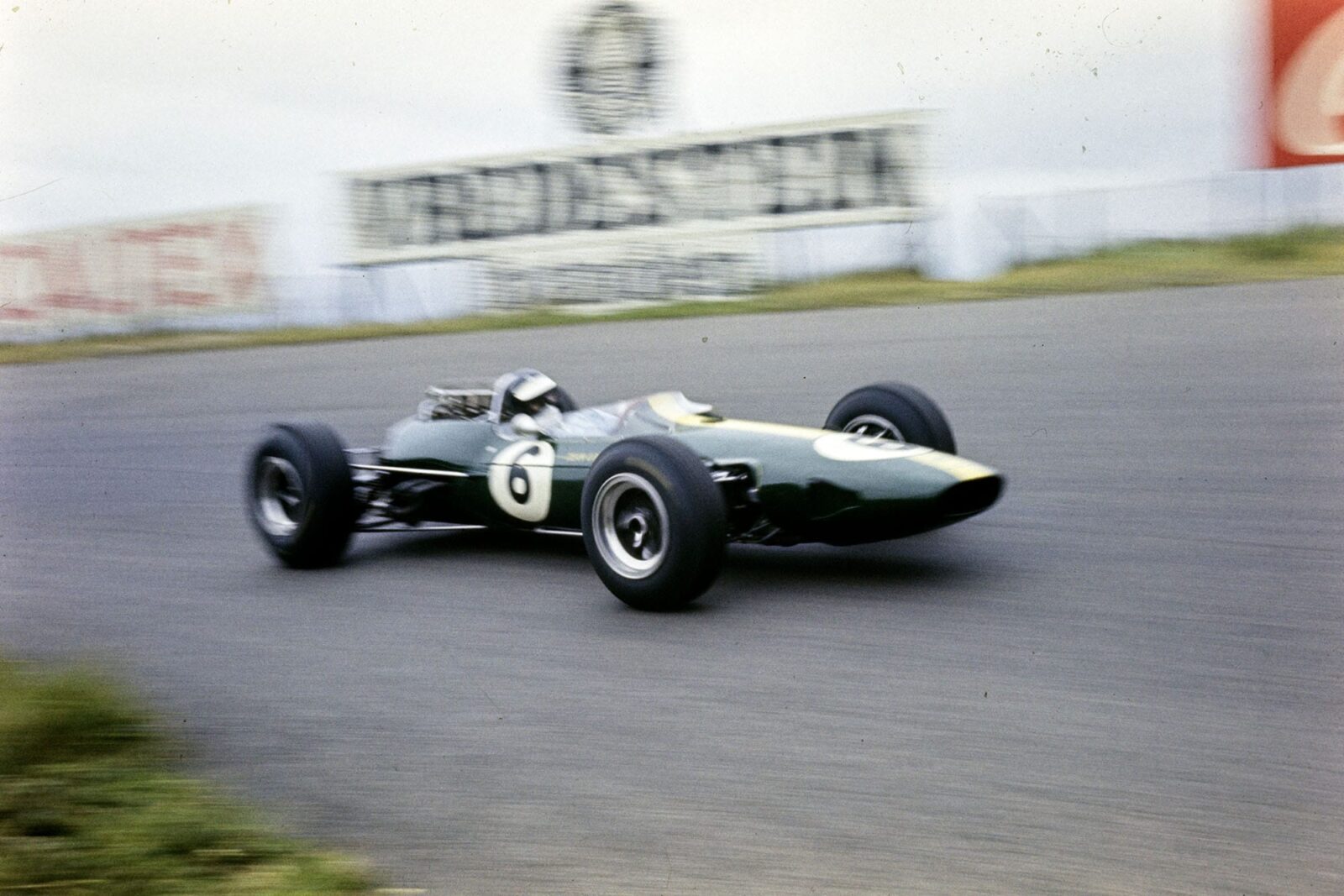
Clark took a fifth win of the season
Motorsport Images
The Dutch Grand Prix is usually held in May and has been the first or second event in the World Drivers’ Championship for several seasons, but this year it was moved to July, to become sixth in the 1965 series. The policy of the organisers now appears to he to try a different date each year, presumably to find which date attracts most spectators. They are hoping for an August date next year but due to a clash with the German GP they are having difficulty in settling on a date, and the FIA still have not decided on which dates these races will be held in 1966.
Zandvoort is a seaside resort on the North Sea coast between Haarlem and The Hague and very close to major cities like Amsterdam and Rotterdam, as well as Brussels in Belgium, so that races at this circuit usually attract good crowds. With the Grand Prix taking place in the holiday season the organisers hoped to attract many casual spectators, and their claimed figure of 60,000 does not seem too optimistic. The large number of holiday-makers made things difficult for the teams, who found their favourite hotels fully booked or unwilling to eater for the peculiar meal-times that drivers, and especially mechanics, have to keep.
The KNAC, who were running the race together with the NAV (equivalent to the RAC and the BRDC), decided to have no truck with qualification and invited 16 drivers to take part, these 10 comprising the six works teams plus two cars each from the Rob Walker and John Willment teams. However, Honda once again decided to enter only one car, while the Willment team sent only one car eventually. The organisers then invited the Parnell team to bring two cars and Bob Anderson to bring his Brabham, putting the total up to 17.
Coming only a week after the British GP, the teams had barely had time to rectify the ravages of that race, so there was little of technical novelty to be seen. Team Lotus brought three cars, two with flat-crank Coventry-Climax engines and one with the 4-valve unit repaired after its Silverstone oil-pressure troubles. The possessors of the other 4-valve Climax engine, the Brabham team, unfortunately (or possibly fortunately) had to do without their 4-valver as it was rather badly damaged on its warm-up lap at Silverstone. A valve head broke on one side of the engine, was somehow ejected up one of the fuel injection intake pipes, hit the wire cage which prevents stones falling into the pipes, and then dropped down another pipe on the opposite cylinder bank, causing tremendous havoc in the cylinder head, which was not repairable in the short time available. Although Brabham have three chassis available they were reduced to two normal 2-valve engines, so these were prepared for Gurney and HuIme, Jack Brabham stepping down in favour of the New Zealander.
BRM brought three cars, to normal specification, for Graham Hill and Jackie Stewart to choose from. Hill’s braking trouble at Silverstone had been traced to a faulty brake cylinder and this was replaced. The Honda team, racing at their “home” circuit, for their garage is in Amsterdam, came with two cars for Richie Ginther to choose from, these remaining much as before except that an air collector box had been fitted over the injection intake trumpets. Although it has not been confirmed officially it appears that Honda will run only one car for Richie Ginther in remaining races.
Ferrari once again entrusted their flat-12 to John Surtees, leaving Lorenzo Bandini with two V8s to choose from. A modified version of the flat-12 is nearing final development at Modena and will make its debut at Monza or even the German GP if testing goes well. The Cooper team brought their three Silverstone cars, two with the Cooper gearbox and the spare car with the Hewland gearbox. The private entries had to be content with their usual cars, having few facilities for making modifications, although Bob Anderson was trying large exhaust megaphones on his Climax engine.
Qualifying
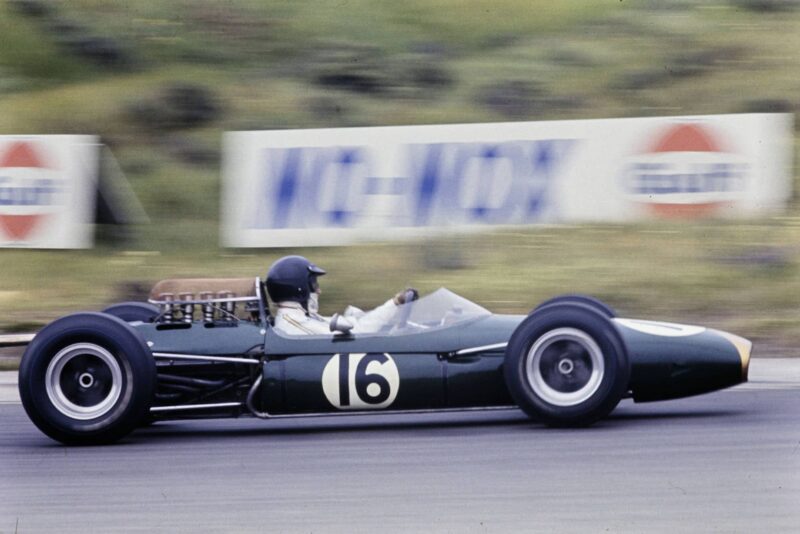
Gurney was finding matching last year’s pace an uphill struggle
Motorsport Images
Practice opened on Friday morning in bitterly cold weather with the threat of rain in the air. Although drivers were ready to start at the appointed time, workmen were still laying fresh tarmac in front of the pits and there was a delay of 30 minutes before practice could begin.
Once practice began Richie Ginther set the early pace, as he has been doing a great deal of testing at Zandvoort in recent months, and he was soon approaching the best practice lap of 1964 set up by Dan Gurney in 1min 31.2sec. He eventually equalled this, but Jim Clark got round in 1min 31.0sec. Dan Gurney couldn’t equal his 1964 time and lapped in 1min 31.7sec like Honda, BRM have recently been testing at Zandvoort but neither Hill nor Stewart could get near Hill’s unofficial record 1min 28.3sec, Stewart lapping at 1min 31.6sec and Hill, who was suffering from a cold, at 1min 31.8sec.
Practice was interrupted for a while when Innes Ireland spun at the Hunze Rug and toppled over one of the sand dunes. This threw the officials into a panic and they hung out the white flag, indicating that an ambulance was on the course, although in fact the clerk of the course motored out onto the track in his BMW 1800. The car was extricated and Ireland soon began circulating again. The officials decided to black-flag him but unfortunately showed Bob Anderson’s number, which peeved the Brabham driver somewhat as he was running in a rebuilt engine alter piston ring breakages at Silverstone.
The rain which had threatened to fall during the morning session began to pour down during lunch and the afternoon session took place in an almost continuous downpour; with the result that most drivers had to try hard to beat 2min. The BRM team were more zealous than most, trying all the permutations on their Dunlop tyres. This resulted in Hill making fastest lap in the afternoon, in 1min 52sec.
The weather improved immensely by Saturday, and the sun shone from a cloudless sky, although the stiff Zandvoort breeze was much in evidence. The track had been used in the morning for practice by two lots of saloon cars and Formula Vee single-seaters, and the track was quite slippery.
The organisation slipped rather badly when two of the Formula Vee cars collided after the Hunze Rug and disappeared down Innes Ireland’s sand dunes. The start-line marshal held out the white flag, the marshal on the approach to the corner held out the yellow flag, while the marshal on the apex held out the oil flag. It was then decided to suspend practice and the start-line marshal held out the red flag, but none of the drivers took any notice and the marshals practically had to throw themselves onto the track to stop the cars, although there was no need as both cars were off the track and the drivers were unhurt. With their swing-axle ‘suspension the Formula Vee cars look dangerous and are very slow anyway.
Although most of the Formula One drivers practised hard they were a long time in reducing their lap times and the only driver to get below 1min 31.0sec was Graham Hill who got the BRM round in 1min 30.7sec.
Jim Clark lost a lot of oil from his 4-valve engine and after the leak was repaired the engine sounded off-colour, so it was decided to use the 2-valve car in the race. Clark’s troubles with the 4-valve car prevented him improving on his first day’s time but he still took the second place on the grid next to Hill with his 1min 31.0sec, although Richie Ginther in the Honda and John Surtees in the flat-12 Ferrari equalled this time on Saturday. Amongst those to spin at the Hunze Rug were Richie Ginther and Jochen Rindt while Lorenzo Bandini had engine trouble with his V8 Ferrari but he was able to switch to the spare car.
Race
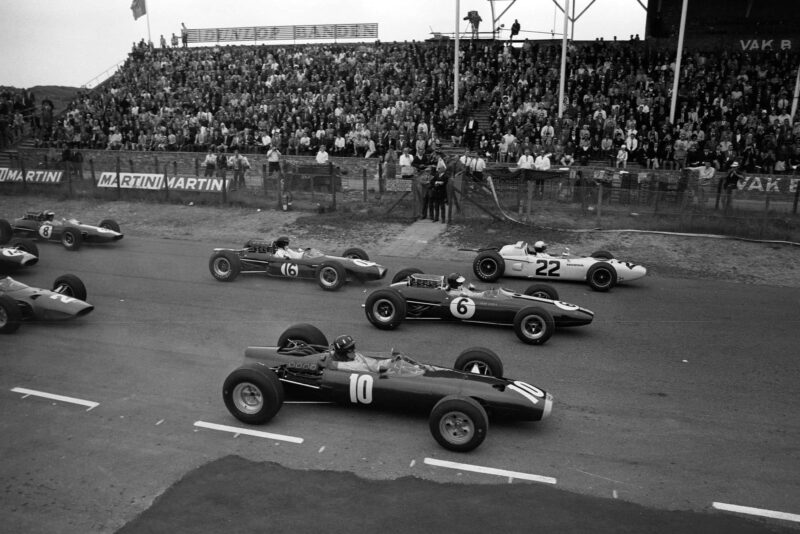
Gurney gets the jump on Clark and Hill at the start
Motorsport Images
Race day looked as if it would be as warm and sunny as the previous day, but after two supporting races for saloons the sky clouded over and a cool breeze sprang up. Although it seemed unlikely that rain would fall few drivers could decide which tyres to use. John Surtees chose Dunlop R7 all round while Bandini had R6 all round, Graham Hill had R6 at the front and R7 at the rear, as did Innes Ireland, while the works Lotuses stuck to R6 all round, as did the Cooper and Rob Walker teams. The Honda, the two Brabhams and Gardner’s Willment Brabham were all on their “all weather” Goodyear tyres.
The start was made from a dummy grid, which for once went smoothly, everyone starting on cue and moving up to the main grid smoothly. A minor diversion was provided by Cohn Chapman who became involved in a punch-up with the Dutch police, which led to his arrest after the race. As the flag dropped Richie Ginther made another fierce start in the Honda from the outside of the front row, getting far enough ahead of Graham Hill to be able to chop across in front at the Tarzan hairpin. Hill followed him round with Clark on the BRM’s tail, followed by Gurney, Stewart and Spence.
“As the flag dropped Richie Ginther made another fierce start in the Honda”
At the end of lap one the Honda was still in the lead but Hill and Clark were pressing Ginther hard, while Gurney and Stewart were not far behind. They were followed by Spence, Surtees, Hulme, Bandini, McLaren, Rindt, Ireland, Gardner, Siffert, Attwood, Bonnier and Anderson. Somehow Ginther managed to stay ahead for a second lap, but then on lap three Hill got past at Tarzan while Clark took two more laps before he slipped past at the same place.
The stage looked set for the decider in the Hill versus Clark battle but Clark slipped inside the BRM at Tarzan on lap six and immediately began opening up an imperceptibly widening gap. Ginther had begun his downward march through the lap chart as first Gurney relegated him to fourth and then Stewart pushed him down to fifth. Surtees got past Spence into sixth place while Rindt got past his team leader McLaren for ninth place. Attwood’s Lotus-BRM was sounding rough at the tail of the field while Bob Anderson brought his Brabham in to retire with overheating. Jo Bonnier soon joined him his Brabham-Climax having ignition and/or fuel feed problems, while the driver had a painful foot due to a swollen toe.
Clark had pulled out a 1.5sec lead on Hill by lap 10, while Gurney was beginning to press the BRM driver hard, although Jackie Stewart was beginning to close the gap on Hill and Gurney. Denis Hulme was beginning to get his Brabham going well, nipping past both Spence and Surtees in quick succession. Surtees was in handling trouble with the Ferrari which seemed to be wearing its tyres out very unevenly and rapidly.
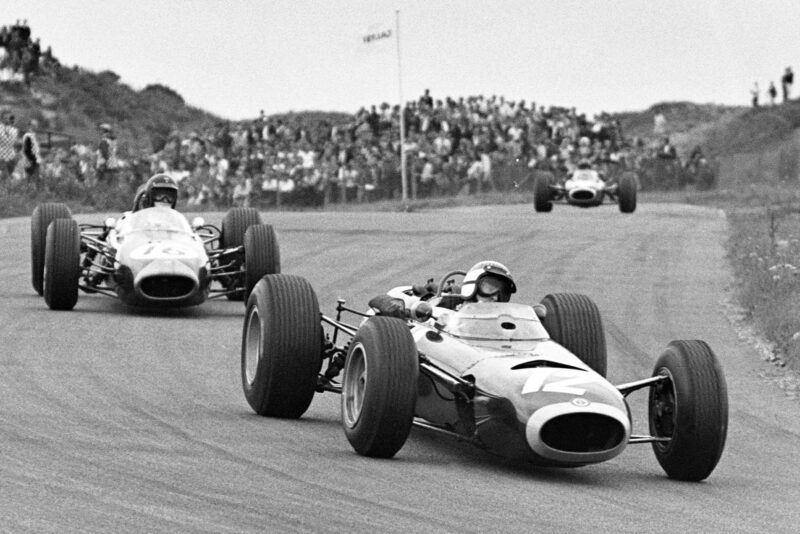
Stewart passed Gurney then set about trying to catch Clark
Motorsport Images
Stewart was still closing the gap on Hill and Gurney and the Brabham driver responded by going round the outside of Hill’s BRM at Tarzan and out-accelerating him into the Hunze Rug bend to take over second place. Further back Ginther lost another place, this time to Hulme and then he spun at the Hunze Rug, dropping him a further place, this time behind Surtees. Jo Siffert had been going well in his Brabham, but misfiring set in and he stopped out on the circuit; a swift kick got it going again but the fuel pressure was low and it misfired and banged its way round for a long while.
Stewart caught Hill and then Gurney with surprising ease and slipped into second place behind Clark, with a 6.5sec deficit to makeup. He started to gnaw away gradually at this lead, knocking off the odd fraction here and there to give the crowd something to think about. However, the Lotus pit were keeping Clark well informed and he began opening out again after a few laps.
More spins occurred at Hunze Rug to keep the crowd on their toes, first Innes Ireland doing it all wrong and then Mike Spence spun on braking, which dropped the Lotus back into a group consisting of Bandini, McLaren and Rindt. McLaren soon retired with a broken crown-wheel and pinion, then Bandini joined the ranks of the Hunze Rug spinners and dropped back somewhat.
“Stewart started to gnaw away gradually at this lead, knocking off the odd fraction here and there to give the crowd something to think about”
Clark still opened out his lead surely but steadily while Stewart, in turn, was leaving Gurney, who in his turn was well clear of Graham Hill, whose BRM had broken its rev-counter early in the race. In fifth place at half-distance was Hulme, while Surtees in sixth was being caught by Ginther, now recovering from a second spin. The second works Cooper retired soon afterwards, as Jochen Rindt had noticed the oil pressure drop to 20psi.
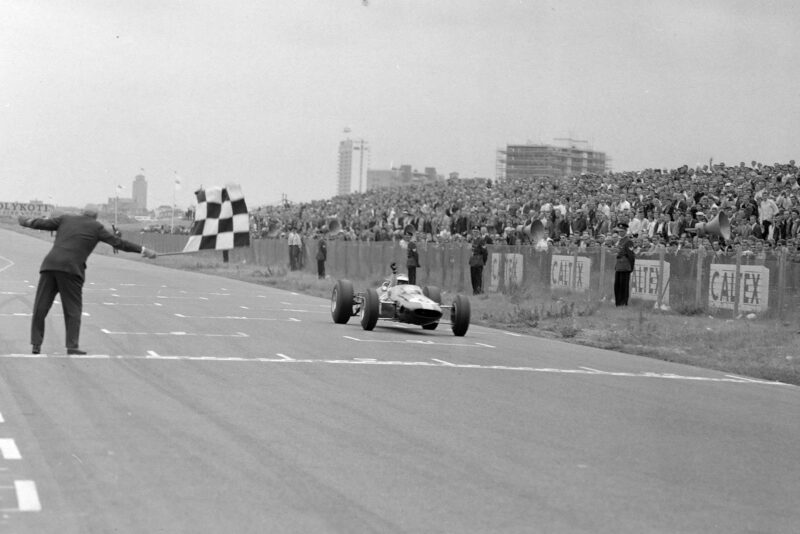
Clark adds another win for the season
Motorsport Images
The order among the leaders remained settled for the rest of the race but Ginther eventually overwhelmed Surtees for sixth place while Bandini got in front of Spence for eighth. Denis Hulme ran into trouble with only a few laps to go when his engine began sounding terribly flat. He rushed into the pits for a quick examination to find that the exhaust manifold on one bank of cylinders had cracked; he went off again without losing a place, although Ginther and Surtees were getting very close to him as the last few laps were reeled off.
Jim Clark eventually crossed the line after 80 laps to win his fifth Championship race in a row with fellow Scot Jackie Stewart a worthy second, with Gurney third and Hill fourth. Denis Hulme held on to his fifth place by a whisker from Ginther and Surtees while Spence surprisingly came by in eighth place on the last lap, having been behind Bandini on the penultimate lap. Eventually Bandini came crawling in with the gearbox jammed in second gear to finish ninth.
